Tour
Packages in Luxor:
Luxor, Thebes, Menf,
and many names given to this place which includes all the
history of the Pharaonic state. Luxor divided into two parts,
the East Band and the West Band, most of life style now is on
the east band where there is an Airport and Rail Station so the
Main Ways coming form the north and going to the south of Egypt.
The
East Band: Karnak Temple, Luxor Temple, Luxor
Museum, Hotels and resorts for accommodating visitors and even
Nile Cruise pavement, here they live an serve all tourists visit
all attractions of Temple and Tombs.
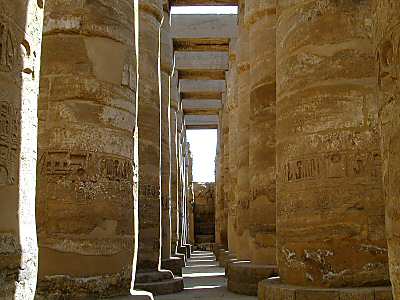 Karnak
Temple: In ancient Egypt, the power of the god Amun of
Thebes gradually increased during the early New Kingdom, and
after the short persecution led by Akhenaton, it rose to its
apex. In the reign of Ramesses III, more than two thirds of the
property owned by the temples belonged to Amun, evidenced by the
stupendous buildings at Karnak. Although badly ruined, no site
in Egypt is more impressive than Karnak. It is the largest
temple complex ever built by man, and represents the combined
achievement of many generations of ancient builders. The Temple
of Karnak is actually three main temples, smaller enclosed
temples, and several outer temples located about three
kilometers north of Luxor, Egypt situated on 100 ha (247 acres)
of land. Karnak is actually the sites modern name. Its ancient
name was Ipet-isut, meaning "The Most Select (or Sacred) of
Places". Karnak takes at least a half of a day just to walk
around its many precincts and years to come to know it well.
Karnak
Temple: In ancient Egypt, the power of the god Amun of
Thebes gradually increased during the early New Kingdom, and
after the short persecution led by Akhenaton, it rose to its
apex. In the reign of Ramesses III, more than two thirds of the
property owned by the temples belonged to Amun, evidenced by the
stupendous buildings at Karnak. Although badly ruined, no site
in Egypt is more impressive than Karnak. It is the largest
temple complex ever built by man, and represents the combined
achievement of many generations of ancient builders. The Temple
of Karnak is actually three main temples, smaller enclosed
temples, and several outer temples located about three
kilometers north of Luxor, Egypt situated on 100 ha (247 acres)
of land. Karnak is actually the sites modern name. Its ancient
name was Ipet-isut, meaning "The Most Select (or Sacred) of
Places". Karnak takes at least a half of a day just to walk
around its many precincts and years to come to know it well.
Luxor Temple:
Many festivals were celebrated in Thebes. The Temple of Luxor
was the center of the most important one, the festival of Opet.
Built largely by Amenhotep III and Ramesses II, it appears
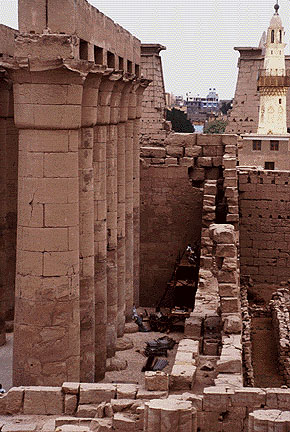 that
the temple's purpose was for a suitable setting for the rituals
of the festival. The festival itself was to reconcile the human
aspect of the ruler with the divine office. During the 18th
Dynasty the festival lasted eleven days, but had grown to
twenty-seven days by the reign of Ramesses III in the 20th
Dynasty. At that time the festival included the distribution of
over 11,000 loaves of bread, 85 cakes and 385 jars of beer. The
procession of images of the current royal family began at Karnak
and ended at the temple of Luxor. By the late 18th Dynasty the
journey was being made by barge, on the Nile River. Each god or
goddess was carried in a separate barge that was towed by
smaller boats. Large crowds consisting of soldiers, dancers,
musicians and high ranking officials accompanied the barge by
walking along the banks of the river. During the festival the
people were allowed to ask favors of the statues of the kings or
to the images of the gods that were on the barges. Once at the
temple, the king and his priests entered the back chambers.
There, the king and his ka (the divine essence of each king,
created at his birth) were merged, the king being transformed
into a divine being. The crowd outside, anxiously awaiting the
transformed king, would cheer wildly at his re-emergence. This
solidified the ritual and made the king a god. The festival was
the backbone of the pharaoh's government. In this way could a
usurper or one not of the same bloodline become ruler over
Egypt.
that
the temple's purpose was for a suitable setting for the rituals
of the festival. The festival itself was to reconcile the human
aspect of the ruler with the divine office. During the 18th
Dynasty the festival lasted eleven days, but had grown to
twenty-seven days by the reign of Ramesses III in the 20th
Dynasty. At that time the festival included the distribution of
over 11,000 loaves of bread, 85 cakes and 385 jars of beer. The
procession of images of the current royal family began at Karnak
and ended at the temple of Luxor. By the late 18th Dynasty the
journey was being made by barge, on the Nile River. Each god or
goddess was carried in a separate barge that was towed by
smaller boats. Large crowds consisting of soldiers, dancers,
musicians and high ranking officials accompanied the barge by
walking along the banks of the river. During the festival the
people were allowed to ask favors of the statues of the kings or
to the images of the gods that were on the barges. Once at the
temple, the king and his priests entered the back chambers.
There, the king and his ka (the divine essence of each king,
created at his birth) were merged, the king being transformed
into a divine being. The crowd outside, anxiously awaiting the
transformed king, would cheer wildly at his re-emergence. This
solidified the ritual and made the king a god. The festival was
the backbone of the pharaoh's government. In this way could a
usurper or one not of the same bloodline become ruler over
Egypt.
The West band: Valley of
Kings, Valley of Queens, Hatchebsut Tomb and Temple, Memnon
Colossis, Medint Habu, it's all tourist attractions on the west
band, you should pass the Nile with felucca or by car over the
bridge to reach this city of death (as it was called by the
pharaohs). it's unbelievable historical places, more than a
dream, it's just the city of death.
El Deir El-Bahri
(Hatchebsut Tomb):
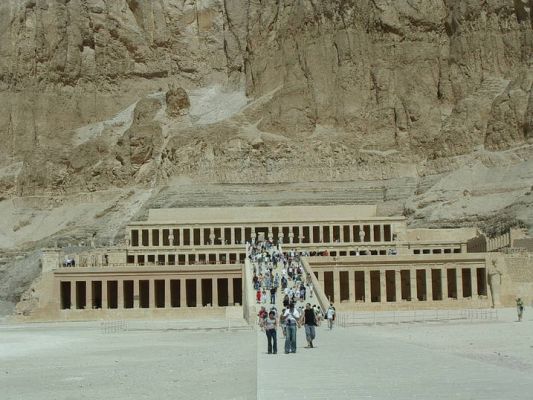 Hatshepsut
is one of the more mysterious figures of ancient Egyptian
history. Much is known of her reign as King, yet so many
questions remain unanswered. Questions such as why late in the
reign of her successor Tutmosis III, 40 years after her death,
did he suddenly seem to embark on a campaign to erase her name
and memory from the lists of Kings. In any case, Hatshepsut has
left a legacy of architectural and statuary elegance. Her temple
built in the area of Thebes, at modern Deir el-Bahri, stands as
a beautiful monument to her reign.
Hatshepsut
is one of the more mysterious figures of ancient Egyptian
history. Much is known of her reign as King, yet so many
questions remain unanswered. Questions such as why late in the
reign of her successor Tutmosis III, 40 years after her death,
did he suddenly seem to embark on a campaign to erase her name
and memory from the lists of Kings. In any case, Hatshepsut has
left a legacy of architectural and statuary elegance. Her temple
built in the area of Thebes, at modern Deir el-Bahri, stands as
a beautiful monument to her reign.
Memonon
Colosses: Ancient Egyptians called the southern of the
two statues "Ruler of Rulers". Later travelers called them "Shammy
and "Tammy", which may have been a corruption of the Arabic
words for "left" and "right". Today they are known locally as
"el-Colossat", or "es-Salamat". The statues are made from carved
blocks of quartzite quarried either at Giza or Gebel es-Silsila.
The Northern statue depicts Amenhotep III with his mother,
Mutemwia, while the southern statue is of Amenhotep III with his
wife, Tiy and one of his daughters. On the sides of the statues
are relief depicting Nile gods joining together plants
symbolizing Upper and Lower Egypt.
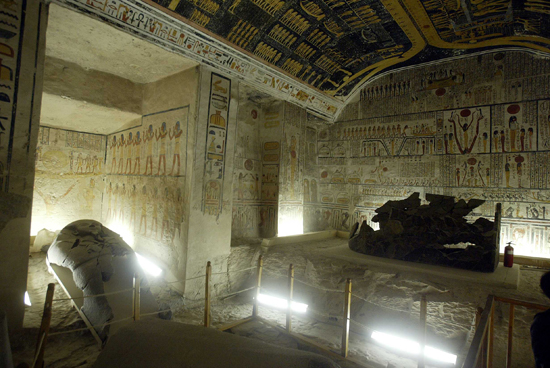 Valley
of Kings: The Valley, known as Biban el-Muluk,
"doorway or gateway of the kings," or, the Wadyein,
meaning "the two valleys," is actually composed of two separate
branches. The main eastern branch, called ta set aat, or
"The Great Place," is where most of the royal tombs are located,
and in the larger, westerly branch where only a few tombs were
cut.
Valley
of Kings: The Valley, known as Biban el-Muluk,
"doorway or gateway of the kings," or, the Wadyein,
meaning "the two valleys," is actually composed of two separate
branches. The main eastern branch, called ta set aat, or
"The Great Place," is where most of the royal tombs are located,
and in the larger, westerly branch where only a few tombs were
cut.
Tombs in the Valley:
The Valley contains 62 tombs
to-date, excavated by the Egyptologists and archaeologists from
many countries. Not all of the tombs belonged to the king and
royal family. Some tombs belonged to privileged nobles and were
usually undecorated. Not all the tombs were discovered intact,
and some were never completed.
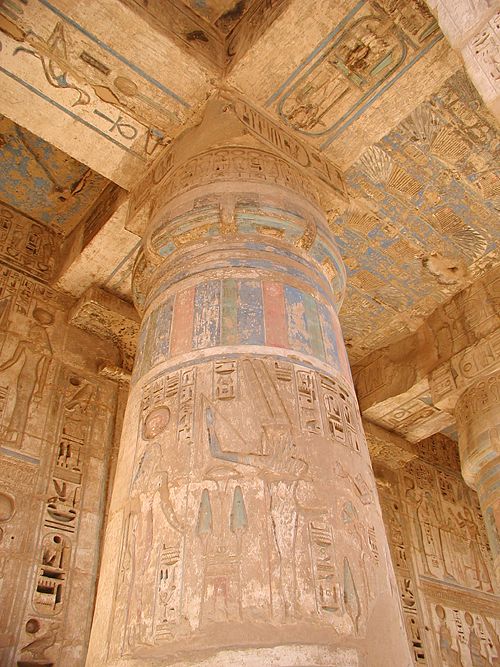 Medinet
Habu: The ancient
Egyptian name for Medinet Habu, in Arabic the "City of Habu" was
Djamet, meaning "males and mothers." Its holy ground was
believed to be where the Ogdoad, the four pairs of first
primeval gods, were buried. Medinet Habu was both a temple and a
complex of temples dating from the New Kingdom. It adjoins the
cultivation at the southern end of the Theban necropolis,
opposite southern Luxor. The area was one of the earliest places
within the Theban region to be associated with the worship of
Amun. Hatshepsut and Tutmosis III built a small temple to Amun
on the site of an earlier structure. Next to their temple,
Ramesses III built his mortuary temple, Medinet Habuís most
conspicuous standing monument.
Medinet
Habu: The ancient
Egyptian name for Medinet Habu, in Arabic the "City of Habu" was
Djamet, meaning "males and mothers." Its holy ground was
believed to be where the Ogdoad, the four pairs of first
primeval gods, were buried. Medinet Habu was both a temple and a
complex of temples dating from the New Kingdom. It adjoins the
cultivation at the southern end of the Theban necropolis,
opposite southern Luxor. The area was one of the earliest places
within the Theban region to be associated with the worship of
Amun. Hatshepsut and Tutmosis III built a small temple to Amun
on the site of an earlier structure. Next to their temple,
Ramesses III built his mortuary temple, Medinet Habuís most
conspicuous standing monument.
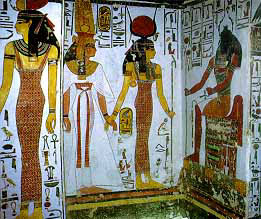 Valley
of Queens: Located
on the West Bank at Luxor (ancient Thebes). There are between 75
and 80 tombs in the Valley of the Queens, or Biban al-Harim.
These belong to Queens of the 18th, 19th and 20th Dynasties. The
Tomb of Nefertari (Tomb 66): One of five wives of Ramesses II,
Nefertari was his favorite and the tomb here has been is said to
be one of the most beautiful in Egypt. The tomb is completely
painted with scenes though out. In most of these, Nefertari,
known as 'the most beautiful of them', is accompanied by gods.
She is usually wearing a golden crown with two feathers extended
from the back of a vulture and clothed in a white, gossamer
gown. Be sure not to miss the side room where one scene depicts
the queen worshipping the mummified body of Osiris. Near the
stairs to the burial chamber is another wonderful scene with
Nefertarti offering milk to the goddess Hathor.
Valley
of Queens: Located
on the West Bank at Luxor (ancient Thebes). There are between 75
and 80 tombs in the Valley of the Queens, or Biban al-Harim.
These belong to Queens of the 18th, 19th and 20th Dynasties. The
Tomb of Nefertari (Tomb 66): One of five wives of Ramesses II,
Nefertari was his favorite and the tomb here has been is said to
be one of the most beautiful in Egypt. The tomb is completely
painted with scenes though out. In most of these, Nefertari,
known as 'the most beautiful of them', is accompanied by gods.
She is usually wearing a golden crown with two feathers extended
from the back of a vulture and clothed in a white, gossamer
gown. Be sure not to miss the side room where one scene depicts
the queen worshipping the mummified body of Osiris. Near the
stairs to the burial chamber is another wonderful scene with
Nefertarti offering milk to the goddess Hathor.
Tour Packages in
Luxor:
